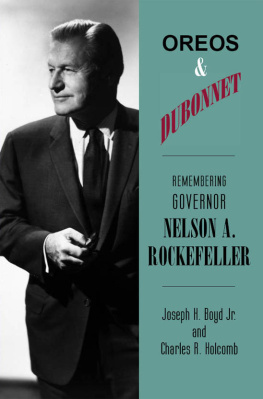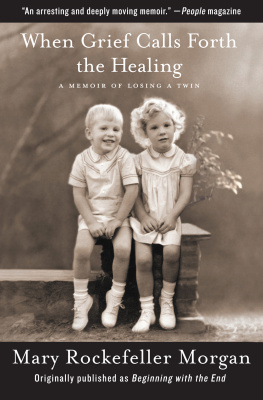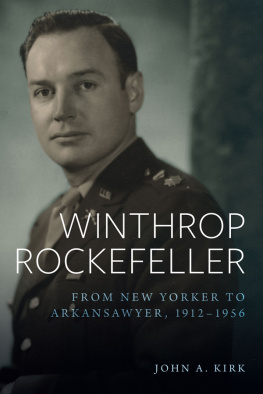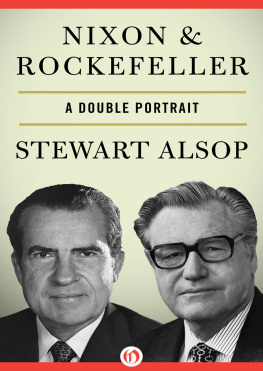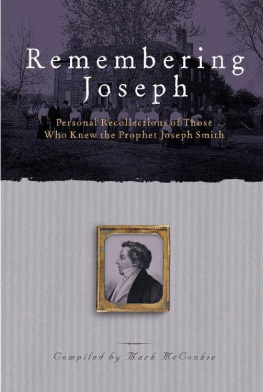Published by State University of New York Press, Albany
Publication of this book was made possible with the support of the New York State Archives Partnership Trust and Robert and Patricia Phillips.
2012 State University of New York
All rights reserved
Printed in the United States of America
No part of this book may be used or reproduced in any manner whatsoever without written permission. No part of this book may be stored in a retrieval system or transmitted in any form or by any means including electronic, electrostatic, magnetic tape, mechanical, photocopying, recording, or otherwise without the prior permission in writing of the publisher.
Excelsior Editions is an imprint of State University of New York Press
For information, contact State University of New York Press, Albany, NY
www.sunypress.edu
Production by Ryan Morris
Marketing by Fran Keneston
Library of Congress Cataloging-in-Publication Data
Boyd, Joseph H.
Oreos and Dubonnet : remembering Governor Nelson A. Rockefeller / Joseph H. Boyd Jr. and Charles R. Holcomb.
p. cm.
Includes index.
Excelsior editions.
ISBN 978-1-4384-4183-2 (hardcover : alk. paper)
1. Rockefeller, Nelson A. (Nelson Aldrich), 19081979. 2. United StatesPolitics and government19741977. 3. New York (State)Politics and government1951 4. Vice-PresidentsUnited StatesBiography. 5. GovernorsNew York (State)Biography. I. Holcomb, Charles R. II. Title.
E748.R673.B69 2012
973.925092dc23
[B]
2011022070
10 9 8 7 6 5 4 3 2 1
This book is dedicated to Joe Boyd's deceased wivesMargaret Mayes Boyd (19431998) and Sara Gear Boyd (19412008)both of whom died of cancer, and to Joan Hamilton Holcomb, whose patience and support despite illness have been indispensable in her husband's completion of this work.
A Word of Introduction
Charles R. Holcomb
Nelson Aldrich Rockefeller had an enormous and long-lasting impact on New York State during his fifteen years as governor, and to some extent, on the country as well. He changed the lives of many, particularly those who worked closely with him over the years.
One such who was there to see it all was Joseph H. Boyd Jr., the initiator and coauthor of this book. He signed on with Rockefeller while still in college and served in various responsible capacities for nearly two decades, primarily during the gubernatorial years, which are the principal focus of the book.
A Long Shot Candidacy
Nelson A. Rockefeller began to consider the possibility of running for governor of New York several years before the 1958 election. He knew that if he ran, he would face very long odds. He had built an impressive record in Washington, serving three presidents, but he was not widely known in New York State. He had no political organization and no record or standing within the Republican Party in New York State. His knowledge of New York State politics and government was sketchy. In July, 1958, he would turn fifty, and he had never before run for any office, much less New York State's highest office. And it was far from certain that he could secure the Republican nomination for governor.
Even if he did get the nomination, he would then have to take on a wealthy and well-entrenched incumbent governor, Democrat W. Averell Harriman. And Harriman, while not the warmest public figure, was a hard worker generally viewed as running a reasonably competent, if dull, administration. Nationally, furthermore, 1958 was expected to be a year of Democratic gains in Congress and in state races all across the country.
Former governor Thomas E. Dewey, who had retired after twelve successful years as governor and two unsuccessful runs for president, was of the opinion that Rockefeller, whose name connoted such vast wealth and power, could not be elected dogcatcher in New York State. He nonetheless gave his former top aide and law partner, R. Burdell Bixby, his blessing to work as director of scheduling for the Rockefeller campaign.
But Rockefeller brought impressive strengths as well. Along with that famous name came formidable personal and family financial resources. He had boundless energy and drive, an electric personality, and unshakeable self-confidence. He also brought the skills, as well as the scars, of nearly two bruising decades of operating in the bureaucratic and political thickets of Washington, where he had held high-level appointive positions in the Roosevelt, Truman, and Eisenhower administrations.
Albany as Stepping Stone
It is fair to say that in seeking the governorship, Nelson Rockefeller didn't plan to make it the career it subsequently became. His goal was to become president of the United States, and Albany looked like the best available stepping stone.
Like many before him, Rockefeller had chafed in appointed office. Washington was where the power was, but serving at the pleasure of the presidentand even reporting to him directlymeant that power and independence were temporary at best, and often illusory. Even high-ranking cabinet or subcabinet appointees were vulnerable to legal, political, and budgetary roadblocks thrown up by special interest groups, by adversaries in Congress, and by other administration officials with competing agendas or policy views.
And so Rockefeller had concluded, as others had done, that he needed the credentials and the independence conferred by high elected office in order to have any chance of reaching the presidency. You had to show not only that you were capable, but that you were electable, and the governorship of a large state could provide the requisite platform for doing so.
In fact, Averell Harriman was trying to do the same thing, and for the same reason. Harriman had an impressive background as a businessman and diplomat. Heir to a railroad fortune, he had built his own business empire and served as chairman of the Illinois Central and Union Pacific railroads from 1932 to 1942. In 1942, Franklin Roosevelt sent his friend Harriman to negotiate the Lend-Lease program with Winston Churchill. But Harriman, too, had been an unknown commodity politically until he won the governorship in 1954 by a razor-thin eleven-thousand-vote margin. That ended twelve years of Republican rule, although the Republicans kept control of both houses of the legislature. Harriman lost out to Adlai Stevenson for the 1956 Democratic nomination for president. Reelection as governor in 1958 would put him in position to compete for the Democratic nomination for president in 1960, or for a high place in a Democratic administration.
Similarly, Rockefeller hoped to use the governorship to build a national reputation as a strong, visionary leader who could get things done, solve big problems, and win elections. New York City's position as the nation's financial and media capital meant that almost anything he did as governor would attract wide newspaper and television coverage. And so it did, although this would later turn out to be a double-edged sword.
Trojan Horse
In any case, Harriman himself had already given Rockefeller a huge, if inadvertent, boost in the summer of 1956 by agreeing to his appointment as chairman of the state's Temporary Commission on the Constitutional Convention. This crucial element in the buildup to Rockefeller's nomination was described by the late Cary Reich in his excellent book



